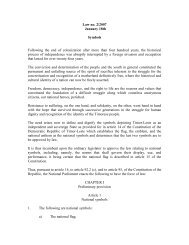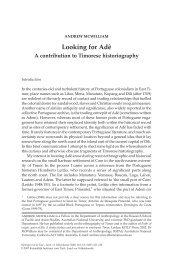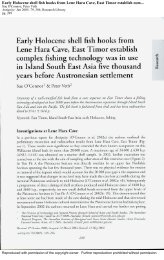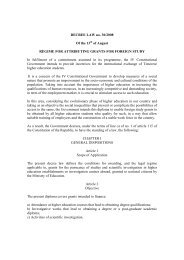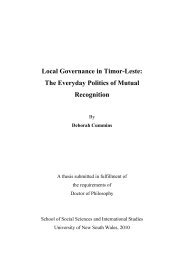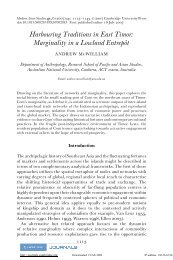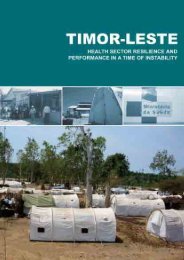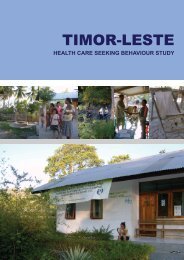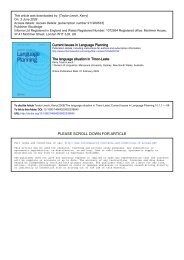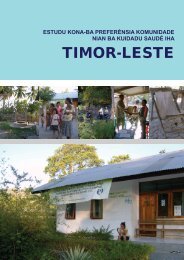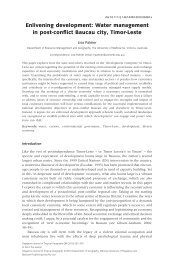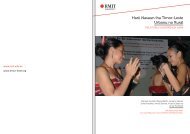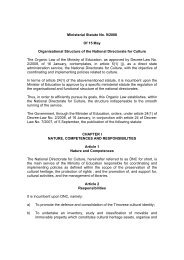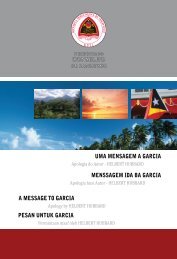The Naueti relationship terminology - Secretaria de Estado da Arte e ...
The Naueti relationship terminology - Secretaria de Estado da Arte e ...
The Naueti relationship terminology - Secretaria de Estado da Arte e ...
Create successful ePaper yourself
Turn your PDF publications into a flip-book with our unique Google optimized e-Paper software.
260<br />
David Hicks<br />
<strong>The</strong> wi<strong>de</strong>r conclusion emerging from this investigation, however, involves<br />
geographical amplitu<strong>de</strong>. Figure 2 shows the respective locations of the<br />
Mambai and <strong>Naueti</strong>, populations separated by a distance of about fifty kilometres<br />
of rugged country occupied by up to half a dozen other ethnolinguistic<br />
groups. Bearing in mind the current status of the Mambai <strong>terminology</strong> as<br />
marking the eastern limits of such systems of nomenclature, it is evi<strong>de</strong>nt that<br />
these limits must now be adjusted to accommo<strong>da</strong>te the findings of the present<br />
analysis. <strong>The</strong> <strong>Naueti</strong> <strong>relationship</strong> <strong>terminology</strong> may now be regar<strong>de</strong>d as the<br />
most easterly instance yet discovered of asymmetric prescriptive alliance in<br />
Southeast Asia.<br />
Acknowledgements<br />
My first period of research on <strong>Naueti</strong> culture commenced in 1966 in the Viqueque<br />
subdistricts of Uato Carabau and Uato Lari, and in Viqueque subdistrict<br />
itself, with funding provi<strong>de</strong>d by the London Committee of the London-<br />
Cornell Project for East and South East Asian Studies, which was supported<br />
jointly by the Carnegie Corporation of New York and the Nuffield Foun<strong>da</strong>tion.<br />
Research was renewed in Viqueque in 1999 with a grant from the American<br />
Philosophical Society and continued intermittently and as part of other<br />
projects for almost eight months in 2005 with funding from the J. William<br />
Fulbright Foreign Scholarship Board. I would like to single out for special<br />
thanks the following individuals who were particularly helpful in aiding me<br />
prepare this paper: Mr. José Caetano Guterres, Mr. Jaquita <strong>da</strong> Costa Guterres,<br />
and Mr. Max Stahl. Further thanks are exten<strong>de</strong>d to the anonymous reviewers<br />
who ma<strong>de</strong> suggestions for improving it.<br />
and ‘wife-givers’, Guermonprez (1998:286) states that ‘these expressions are used when necessary<br />
to distinguish the two kinds of affines merged by the kinship vocabulary’. This is in<strong>de</strong>ed correct.<br />
However, in going on to add ‘To my knowledge, the published ethnography on Eastern Indonesia<br />
contains no explicit information on this subject’ (Guermonprez 1998:292, note) he invites<br />
reference to two such populations who do, as a matter of fact, employ this very <strong>de</strong>vice. For the<br />
Kairui it has been noted that ‘This diagnosis confers upon the Kairui <strong>terminology</strong> a distinctive<br />
interest, for the term for the bilateral female cross-cousin (sai) is modified by the terms appropriate<br />
to wife-giver (umane) and wife-taker (uasa) to distinguish between the two lines, a <strong>de</strong>vice suggesting<br />
in the <strong>de</strong>velopmental sequence that this <strong>terminology</strong> falls between the symmetry of the<br />
Northern Tetum and Mbae, and the asymmetry of the western Manggarai’ (Hicks 1990:67). <strong>The</strong><br />
same verbal resource appears in the <strong>relationship</strong> <strong>terminology</strong> of the aforementioned Makassai,<br />
where the bilateral category sai (minimal specifications: MBC, FZC) may be qualified when situationally<br />
required by the terms for ‘wife-giver’ (umaraha) or ‘wife-taker’ (tupumata) respectively<br />
(Hicks 1990:73-4).



